Josef Zehner | |
|---|---|
| Nationality | Austrian |
| Known for | Botanical illustrator |


Josef Zehner aka Joseph Zehner (fl. 19th century) was an Austrian botanical illustrator. The plant genus Zehneria in the family Cucurbitaceae was named in his honour. [1]
Josef Zehner | |
|---|---|
| Nationality | Austrian |
| Known for | Botanical illustrator |


Josef Zehner aka Joseph Zehner (fl. 19th century) was an Austrian botanical illustrator. The plant genus Zehneria in the family Cucurbitaceae was named in his honour. [1]

Thallophytes are a polyphyletic group of non-motile organisms traditionally described as "thalloid plants", "relatively simple plants" or "lower plants". They form an abandoned division of kingdom Plantae that include lichens and algae and occasionally bryophytes, bacteria and slime moulds. Thallophytes have a hidden reproductive system and hence they are also incorporated into the similarly abandoned Cryptogamae, as opposed to Phanerogamae. Thallophytes are defined by having undifferentiated bodies, as opposed to cormophytes (Cormophyta) with roots and stems. Various groups of thallophytes are major contributors to marine ecosystems.
Stephan is a male given name, a variant of Stephen.

Stephan Ladislaus Endlicher also known as Endlicher István László was an Austrian botanist, numismatist and Sinologist. He was a director of the Botanical Garden of Vienna.

Eduard Friedrich Poeppig was a German botanist, zoologist and explorer.
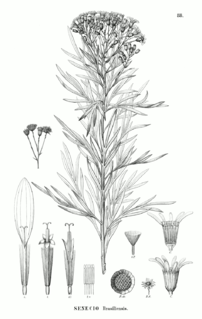
Flora Brasiliensis is a book published between 1840 and 1906 by the editors Carl Friedrich Philipp von Martius, August Wilhelm Eichler, Ignatz Urban and many others. It contains taxonomic treatments of 22,767 species, mostly Brazilian angiosperms.
Acanthocephalus is a genus of plants in the family Asteraceae, described as a genus in 1842.

Thryptomene is a genus of flowering plants in the family Myrtaceae and is endemic to Australia. Plants in the genus Thryptomene are shrubs with small leaves arranged in opposite pairs and white or pink flowers. About forty-seven species of Thryptomene, occurring in all Australian states and the Northern Territory, have been formally described.
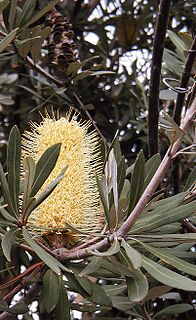
Banksia sect. Eubanksia is an obsolete section of Banksia. There have been two circumscriptions, one of which is synonymous with the recently abandoned B. subg. Banksiasensu Alex George, the other having no modern equivalent.
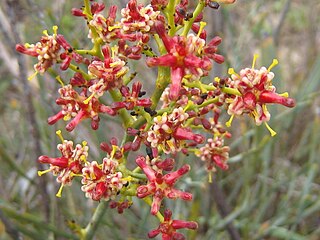
Stirlingia, commonly known as blueboy, is a genus of 7 species in the family Proteaceae, all of which are endemic to Western Australia.
Enumeratio plantarum quas in Novae Hollandiæ ora austro-occidentali ad fluvium Cygnorum et in sinu Regis Georgii collegit Carolus Liber Baro de Hügel is a description of the plants collected at the Swan River colony and King George Sound in Western Australia. The author, Stephan Endlicher, used a collection arranged by Charles von Hügel to compile the first flora for the new settlements. Hugel visited the region during 1833–1834, several years after the founding of the colony. The work provided formal descriptions, in Latin, of new species and genera of plants. The single instalment was produced in Europe by Endlicher in 1837, the work also included contributions by Eduard Fenzl, George Bentham, Heinrich Wilhelm Schott.

Anthotroche is a genus of shrubs in the family Solanaceae. The genus is endemic to Western Australia.

Grevillea integrifolia, commonly known as entire-leaved grevillea, is a species of flowering plant in the family Proteaceae and is endemic to the south-west of Western Australia. It is an erect shrub with egg-shaped leaves, the narrower end towards the base, and cylindrical clusters of white to creamy-white flowers.

Sequoia is a genus of redwood coniferous trees in the subfamily Sequoioideae of the family Cupressaceae. The only extant species of the genus is Sequoia sempervirens in the Northern California coastal forests ecoregion of Northern California and Southwestern Oregon in the United States. The two other genera, Sequoiadendron and Metasequoia, in the subfamily Sequoioideae are closely related to Sequoia. It includes the tallest trees, as well as the heaviest, in the world.
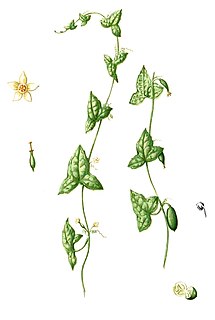
Zehneria is a genus of flowering plants – of vines in the cucumber and gourd family, Cucurbitaceae. It contains about 35 species ranging from Africa, through Southeast Asia to Australia and Oceania. The name honours botanical artist Joseph Zehner.

Eduard Fenzl was an Austrian botanist.
Ursula Endlicher is a New York City based Austrian multi-media artist who creates works in the fields of internet art, performance art and installation art.

Conospermum huegelii, commonly known as the slender smokebush, is a plant endemic to Western Australia.

Endlicher's Glossary is a glossary composed of eighteen lines of Gaulish words, mainly to do with regional placenames, translated into Latin. There are seven surviving copies of it, with the oldest dating to the 8th century.

Anthotroche pannosa is an erect or sprawling shrub in the family Solanaceae. It is found in Western Australia.
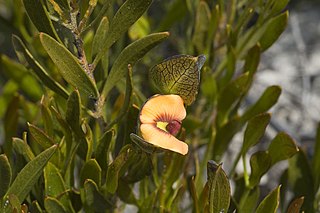
Daviesia alternifolia is a species of flowering plant in the family Fabaceae and is endemic to the south-west of Western Australia. It is a dense, spreading shrub with scattered, egg-shaped phyllodes with the narrower end towards the base, and orange and red flowers with a greenish-yellow centre.